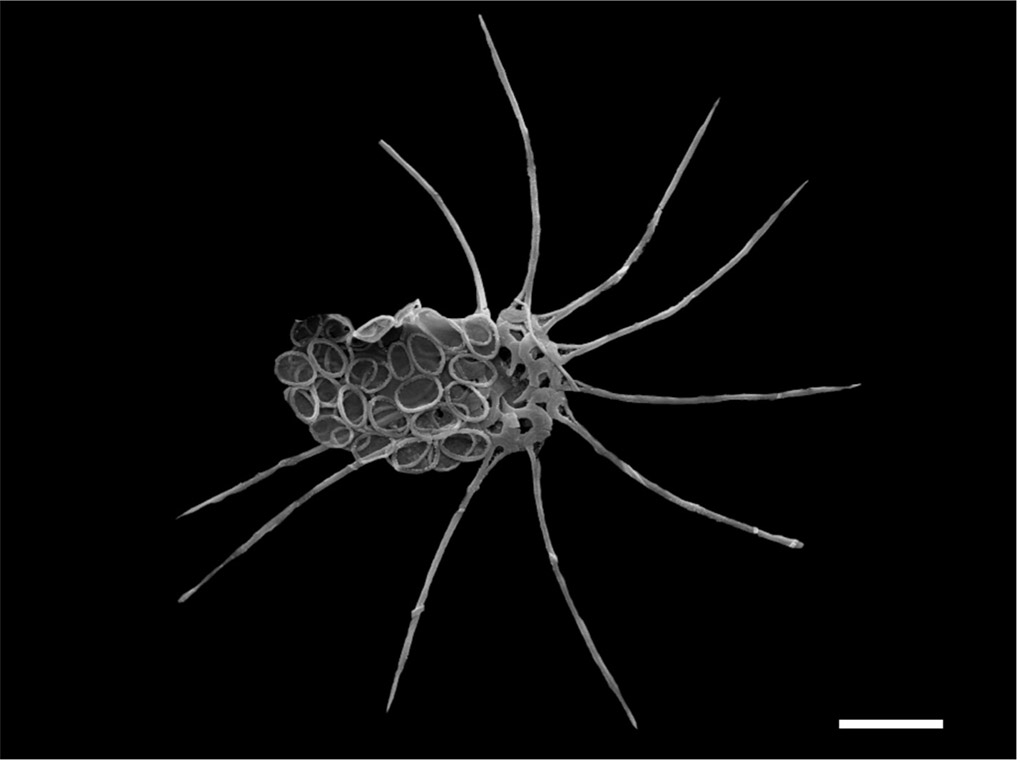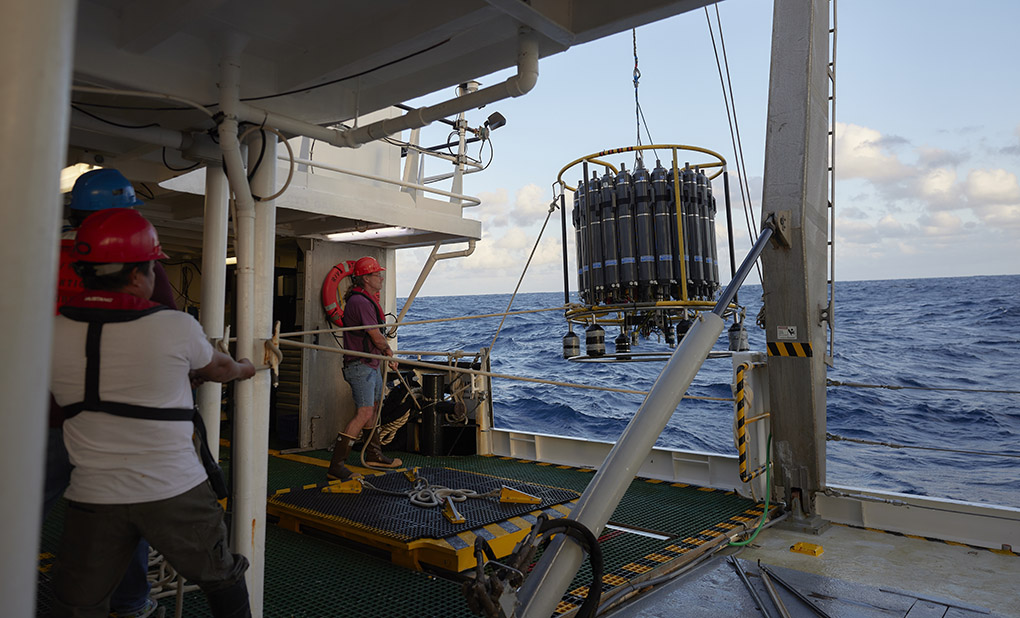Discovery of a New Calcifying Phytoplankton Species off Bermuda

Skeleton of the new species, Calciopappus curvus observed under a scanning electron microscope at the Natural History Museum London (UK). Scale bar = 2 μm.
A newly described coccolithophore species, Calciopappus curvus was recently found in 2020 in the Sargasso Sea near Bermuda by scientists affiliated with the Bermuda Institute of Ocean Sciences, a unit of the Julie Ann Wrigley Global Futures Laboratory at Arizona State University (ASU BIOS). This newly named species has also been observed prior to its discovery off Bermuda in water samples from far-flung locations as the North Atlantic to tropical and subtropical regions of the Mediterranean, the Atlantic, Indian, and Pacific Ocean.
The new species, formally named Calciopappus curvus, is described in a new paper published in the October edition of the journal Protist. The species name derives from its curved appendages that distinguish it from other members of its genus.
“We were intrigued that this new species appeared unexpectedly during examination of the phytoplankton community in various environments. Although rarely and informally reported before, the substantial number of new specimens brought together from our collections made us able to formally describe it” said Odysseus Archontikis, lead author of the Protist article (“Taxonomy and morphology of Calciopappus curvus sp. nov. (Syracosphaeraceae, Prymnesiophyceae), a novel appendage-bearing coccolithophore”).
The discovery occurred while PhD candidates, Odysseus Archontikis at the University of Oxford, and Josué G. Millán at Indiana State University, prodigiously met at an international conference in France dedicated to the study of coccolithophores. There, they engaged in conversations and examined together hundreds of available images of coccolithophores taken from ocean water around the world. Their encounter follows the discovery of an incredibly diverse plankton community living in the Sargasso Sea at Hydrostation 'S' – ASU BIOS’s deep-water research location – where samples were collected, analyzed and described for Josue’s PhD research in collaboration with ASU BIOS zooplankton ecologist Leocadio Blanco-Bercial.
“Josué came to BIOS for a very specific experiment, and what he found in his samples was a treasure for taxonomists, and an example of how much we still need to learn about plankton biodiversity” indicates Blanco-Bercial. “Josué is now coordinating with several international teams of specialized taxonomists to carefully characterize all the new species discovered in this area”.

Aboard the research vessel Atlantic Explorer. Samples were collected within the incredibly diverse plankton community living in the Sargasso Sea at Hydrostation 'S' – ASU BIOS’s deep-water research location. Photo by Jeff Netwon.
Millán added “The Sargasso Sea is a hotspot for algae diversity, there is no better name for this region than its own. The latest discoveries from this ecosystem have demonstrated there is still much more to learn from the oceans. I am glad that this collaborative effort has allowed to finally give justice to a species that is so rare to find. I hope to keep seeing more integrative scientific projects and international collaborations at BIOS to study this beautiful location”.
In Protist, the authors note that Calciopappus curvus differs substantially from the other two species in its genus (Calciopappus caudatus and Calciopappus rigidus) “in terms of morphology and biometry, and, therefore, warrants its circumscription as a distinct species.”
“This species is highly distinctive because it produces one of the most intricate skeletons among the realm of living coccolithophores. We are not entirely sure why these long curved structures vary in orientation, but we suspect they may aid movement or protection against predators,” said Archontikis, adding that the extended radial arms might reflect a defensive response to environmental stress.
The discovery and description of this new species add to the characterization of coccolithophore biodiversity, which is comprehensively displayed on the online library, Nannotax. This resource contains images and taxonomic information showcasing a spectrum of ancient and modern coccolithophore diversity, encompassing around 4,500 species.
“Within the oceanic plankton, coccolithophores are a ubiquitous and abundant group, but show relatively low diversity and have complex morphologies allowing reliable identification. A key objective of our work is to fully document the taxonomic diversity within this group and so allow it to be used as a model group for understanding evolution and biodiversity within the plankton. The remarkable assemblages being collected off Bermuda are proving key to achieving this objective” said Jeremy Young, senior researcher at University College London and nannoplankton specialist.
Amos Winter, Professor at Indiana State University, also commented “Finding a new coccolithophore species especially recently is very exciting as it is getting rarer to discover them because they have been observed for over many decades and there are not that many of these single-cell marine algae left to describe.”
Coccolithophores are major marine photosynthesizers and are among the most productive calcifying organisms on Earth. Coccolithophores, including Calciopappus curvus, are integral to regulating the marine carbon cycle – a process critically linked to regulation of Earth’s climate. Their delicately shaped coccoliths become the main component of marine sediments when they sink to the ocean floor, thus resulting in the formation of limestone and chalk deposits over geological time.
“They have a fossil record that stretches back 200 million years, and the accumulation of their coccoliths onto the ocean floor helps generate calcium-carbonate sediments” Archontikis said. “Then, through subduction zones, calcium carbonate gets into the Earth and via volcanoes, it returns to the Earth’s atmosphere as CO2. So, they do have a fascinating role in settling our atmospheric composition.”
In addition to Archontikis, Millán, Blanco-Bercial, Winter and Young, scientists whose research findings contributed to the Protist paper include: Harald Andruleit of Bundesanstalt fur Geowissenshaften und Rohstoffe, Hanover, Germany; Lluïsa Cros, Institut de Ciencies del Mar, Barcelona, Spain; Annelies Kleijne, Naturalis Biodiversity Center, The Netherlands; Mikal Heldal, University of Bergen, Bergen Norway; and Hai Doan-Nhu, Viet Nam Academy of Science and Technology, Nha Trang, Viet Nam.
The next logical step to better decipher the nature of this new species, would be to gain a better understanding of genetics of Calciopappus curvus’ said Archontikis, who is studying the evolutionary history of calcifying phytoplankton over the past 2.5 million years.
“One promising approach would involve attempting to isolate this new species in culture. This would enable us to conduct comprehensive genetic analysis, unravel its DNA makeup, and place it within a genetic framework,” he said. “While our current research has primarily focused on examining morphology, we should now explore other aspects such as its biology and the way it forms its crystals. This would help elucidate the nature of crystal formation in plankton and their interplay with our oceans’ chemistry.”
To read the full Protist article, visit: www.elsevier.de/protis.
